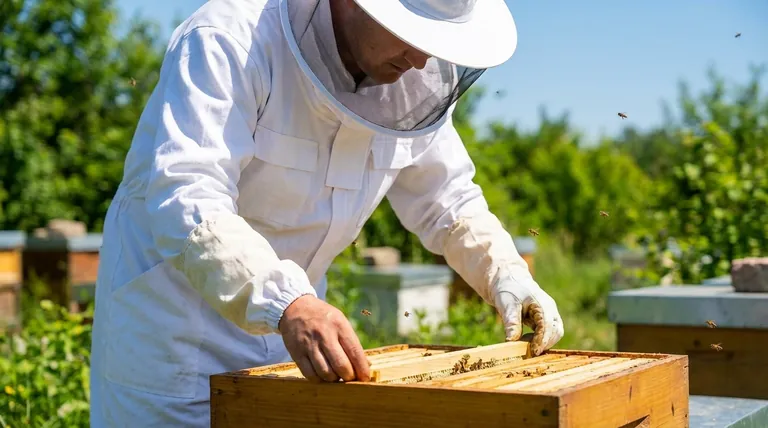When choosing a bee suit, your primary considerations should be the material's suitability for your climate, a loose and comfortable fit, and the quality of its protective features like the veil, zippers, and elastic cuffs. These elements work together to ensure both your safety and your ability to work effectively.
The ideal bee suit is not merely a barrier against stings; it is a carefully balanced tool that provides impenetrable protection without sacrificing the comfort and mobility required for confident beekeeping.

Deconstructing a Quality Bee Suit
Understanding the individual components of a bee suit and why they matter is the first step toward making an informed decision. The right combination of features will directly impact your safety and comfort during hive inspections.
Material and Ventilation
The fabric of your suit is the foundation of your protection and comfort. Polycotton blends are a popular choice, offering a good balance between durability and wearability.
For beekeepers in hotter regions, ventilated suits are essential. These are often made of a triple-mesh or high-quality air mesh construction that allows for maximum airflow while preventing stings.
Conversely, thicker cotton or polycotton suits provide more insulation, which can be beneficial in cooler climates.
The Veil: Your Window to the Hive
The veil is arguably the most critical component for your personal safety. A high-quality veil should offer excellent visibility and be constructed from sturdy material that holds its shape, keeping bees away from your face.
Ensure the veil attaches securely to the suit, leaving no gaps for bees to enter.
Secure Closures: The First Line of Defense
Bees are adept at finding small openings. Your suit must have sturdy, high-quality zippers that are easy to use even with gloves on.
Elastic cuffs and ankles are non-negotiable features. They create a tight seal around your wrists and boots, forming a critical barrier that prevents bees from crawling inside your suit.
Functional Design and Durability
A well-designed suit enhances the beekeeping experience. Look for large pockets to hold essential tools like hive tools or queen markers.
The overall durability and quality of the materials will determine the lifespan of your suit, making it a worthwhile investment.
Common Pitfalls to Avoid
Choosing the right suit is only half the battle. Proper use and maintenance are critical to ensuring your safety visit after visit.
The Danger of a Tight Fit
Never wear a suit that is too tight. When the fabric is stretched taut against your skin, a bee's stinger can more easily penetrate the material. Always opt for a loose, baggy fit.
Neglecting Suit Integrity
Before every trip to your hives, perform a thorough inspection of your suit. Check carefully for any holes or tears, no matter how small, and repair them immediately.
Failing to Seal All Entry Points
A common mistake for beginners is failing to secure all closures properly. Double-check that all zippers are fully closed and that your elastic cuffs are sealed snugly over your gloves and boots, leaving no gaps for bees to enter.
Making the Right Choice for Your Goal
Your specific needs will dictate the best suit for you. Use your primary goal as a guide to focus on the features that matter most.
- If your primary focus is comfort in a hot climate: Choose a fully ventilated, triple-layer mesh suit for maximum airflow.
- If your primary focus is maximum protection and durability: Opt for a high-quality polycotton blend suit known for its resilience and protective qualities.
- If your primary focus is frequent and active beekeeping: Invest in a suit with reinforced knees, ample pockets, and high-quality zippers that can withstand heavy use.
Ultimately, investing in a quality bee suit is an investment in your own safety and confidence as a beekeeper.
Summary Table:
| Feature | Key Consideration | Benefit |
|---|---|---|
| Material | Polycotton for durability; Ventilated mesh for hot climates | Balances protection with comfort and airflow |
| Veil | Sturdy material that holds shape, secure attachment | Ensures clear visibility and prevents facial stings |
| Closures | High-quality zippers; Elastic cuffs & ankles | Creates a secure barrier with no gaps for bees to enter |
| Fit & Design | Loose, baggy fit; Reinforced knees; Large pockets | Prevents sting penetration and enhances mobility for work |
Equip your commercial apiary or distribution business with confidence. HONESTBEE supplies durable, high-performance beekeeping suits and protective equipment designed for the demands of professional beekeepers. Our wholesale-focused operations ensure you get the quality and reliability you need. Contact us today to discuss your equipment requirements and elevate your beekeeping safety standards.
Visual Guide

Related Products
- Cotton Beekeeping Suit and Round Hat with Veil Bee Keeper Protective Gear
- Beekeeping Jacket with Hood and Veil for Beekeepers
- White Beekeeping Protective Suit and Hat with Fencing Veil for Beekeepers
- Professional Beekeeping Suit for Kids and Girls Childrens Bee Keeper Suit
- Heavy Duty Cowboy Beekeeper Hat with Visibility Veil Outdoor Professional Beekeeping Protective Gear
People Also Ask
- What factors should be considered when choosing a beekeeping suit? Balance Safety, Comfort & Performance
- What are the benefits of a fully ventilated beekeeping suit? Stay Cool and Protected in Hot Climates
- What are bee suits made of? Choosing the Right Material for Maximum Protection & Comfort
- Do beekeeping suits completely prevent stings? Maximize Your Apiary Safety with the Right Gear
- How should a bee suit be cleaned? Protect Your Investment and Ensure Apiary Safety



















